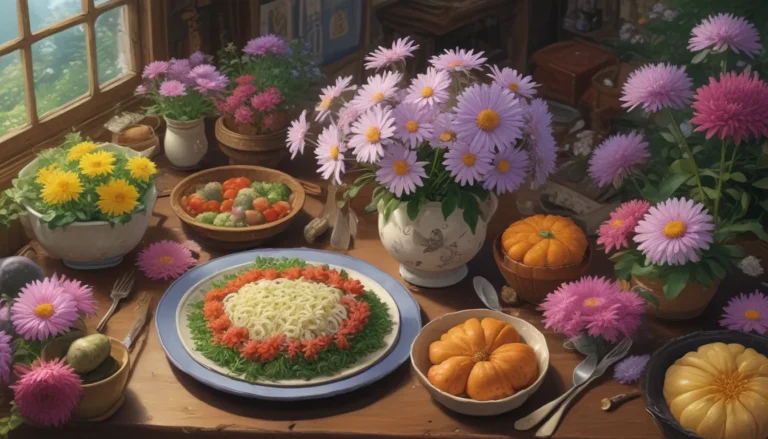The Comprehensive Guide to Planting and Growing Sensational Sunflowers

Are you looking to add a touch of joy to your garden this summer? Sunflowers are the perfect choice! These cheerful blooms are not only beautiful to look at but also offer a variety of culinary and aesthetic benefits.
In this in-depth guide, we will cover everything you need to know to grow your own spectacular Helianthus annuus flowers. From cultivation and history to propagation, growing tips, cultivar selection, pest and disease management, harvesting, preserving, and even recipes and cooking ideas, we’ve got you covered.
So get ready to embark on a sunflower-growing journey that will bring sunshine to your garden and joy to your heart.
What You’ll Learn
- Cultivation and History
- Propagation
- How to Grow
- Growing Tips
- Cultivars to Select
- Managing Pests and Disease
- Harvesting
- Preserving
- Recipes and Cooking Ideas
- Quick Reference Growing Guide
Cultivation and History
Sunflowers are more than just pretty faces. They have a rich history and are widely cultivated for their culinary uses. Originating in North America, these flowers have traveled the world, with major producers including Ukraine, Russia, Argentina, Turkey, France, Hungary, Spain, and China.
Helianthus annuus is a member of the Asteraceae family, known for heliotropic behavior—following the sun as it moves across the sky. With their multiple uses in cooking, bird feed mixes, and even oil production, sunflowers are a versatile addition to any garden.
Propagation
Growing sunflowers is a breeze, making them the perfect choice for beginners or a fun project for kids. You can propagate them from seeds or transplant seedlings from the store.
Growing from Seed
When sowing directly into your garden, plant sunflower seeds in shallow trenches with well-draining soil and ample sunlight. Space the seeds according to your desired flower head size, with smaller spacing producing larger heads. Once germinated, thin out any overcrowded seedlings to promote healthy growth.
For indoor sowing, start a few weeks before the last frost date to avoid seedlings outgrowing their containers.
Transplanting Seedlings
If you opt for transplanting seedlings, choose a sunny location with rich soil. Dig appropriate-sized holes for the root balls and water in well. Branching varieties require more space than single-stem types, so check the seed packet for spacing recommendations.
How to Grow Sunflowers
Sunflowers thrive in warm temperatures and full sun. Water regularly, staking tall varieties if needed. Pinch the tops of branching varieties for bushy growth and consider adding a balanced fertilizer to promote healthy growth. Keep an eye out for any drooping flowers and refer to our troubleshooting guide for solutions.
Growing Tips
- Plant after the last frost.
- Keep seeds moist until germination.
- Plant in an area with full sun.
- Fertilize lightly with a balanced 5-5-5 NPK fertilizer.
- Occasionally your flowers may get a bit droopy, use our guide to troubleshoot this issue.
Sunflower Cultivars to Select
Choose from a variety of sunflower cultivars to suit your garden needs. From the towering ‘Mammoth Russian’ to the delicate ‘Wild Sunflower’ and the unique ‘Velvet Queen,’ there’s a sunflower for every preference. Check out our supplemental guide for more popular varieties to consider.
Managing Pests and Disease
Sunflowers are vulnerable to pests and diseases that can impact their growth and health. From omnivorous squirrels and birds to hungry insects like cutworms, grasshoppers, sunflower beetles, bud moths, and headclipping weevils, there’s a range of challenges to watch out for.
Common diseases such as Alternaria blight, phoma black stem, phomopsis stem canker, rust, and white mold can also affect sunflowers. Stay vigilant and take preventive measures to protect your plants.
Harvesting Sunflower Seeds
Harvest sunflower seeds after the flower petals have wilted and dropped off. Cut the seed heads with a portion of the stem and hang them to dry. Once dry, extract the seeds and store them for planting next season or enjoy them as a nutritious snack.
Preserving
Storing sunflower seeds for extended periods involves keeping dried seeds in a brown paper bag. Different storage methods apply for raw, roasted, shelled, or unshelled seeds, so choose the right approach based on your preferences.
Recipes and Cooking Ideas
Sunflower seeds are not just for snacking—they can be incorporated into a variety of dishes. From pesto to breading for fried chicken, sunflower seeds add a nutritional boost to your meals. Explore our recipes for inspiration and discover new ways to enjoy these versatile seeds.
Quick Reference Growing Guide
- Plant Type: Annual
- Native to: North America
- Hardiness (USDA Zone): 2-11
- Bloom Time / Season: Spring, summer, early fall
- Exposure: Full sun
- Spacing: 2-12 inches, depending on variety
- Water Needs: Low to moderate
- Common Pests: Cutworms, grasshoppers, headclipping weevils
- Common Disease: Alternaria blight, phoma black stem, phomopsis stem canker, rust, white mold
Whether you’re a seasoned gardener or just starting out, growing sunflowers is a rewarding experience. With their vibrant colors, delightful blooms, and tasty seeds, sunflowers are sure to bring a touch of sunshine to your garden. Share your sunflower growing experiences in the comments below and spread the joy of these sensational flowers with your friends and family.
For more sunflower growing tips and advice, check out our additional resources on native swamp sunflowers, sunflower types, and using sunflowers as cover crops. Let the sun shine on your garden with these fascinating plants!
*Enjoy the process of growing your own sunflowers and reaping the rewards of their beauty and bounty. Happy gardening!





